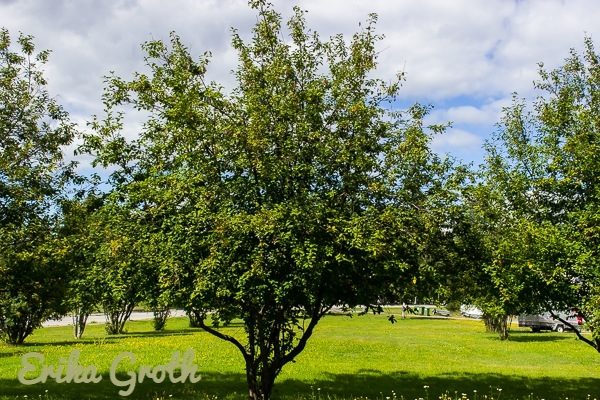
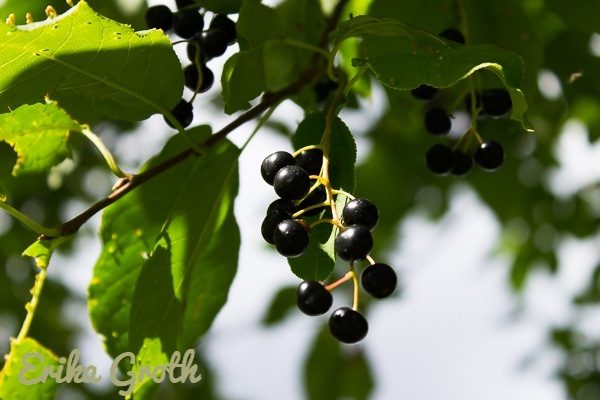
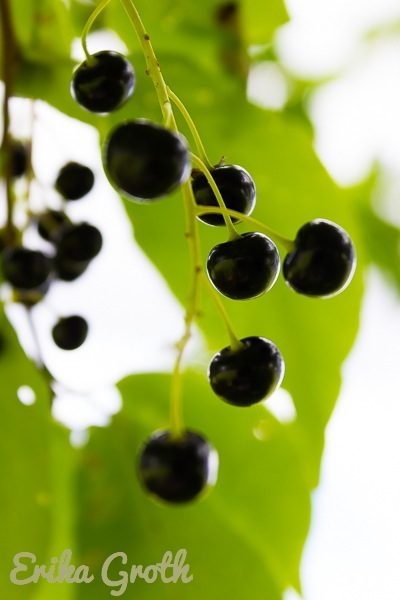
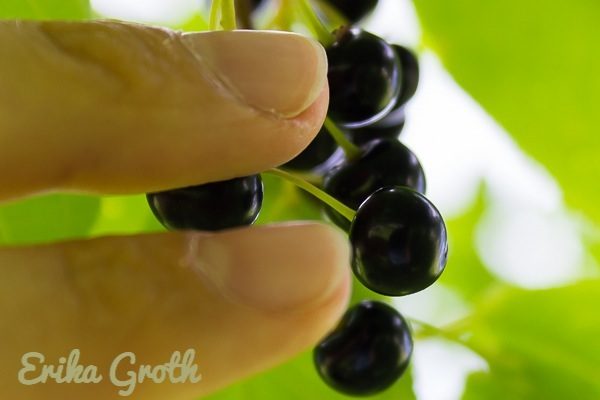
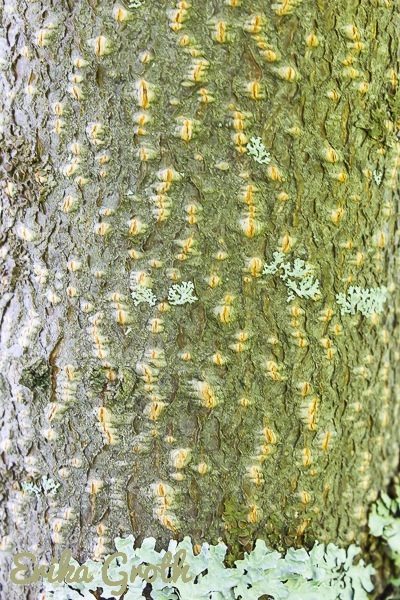
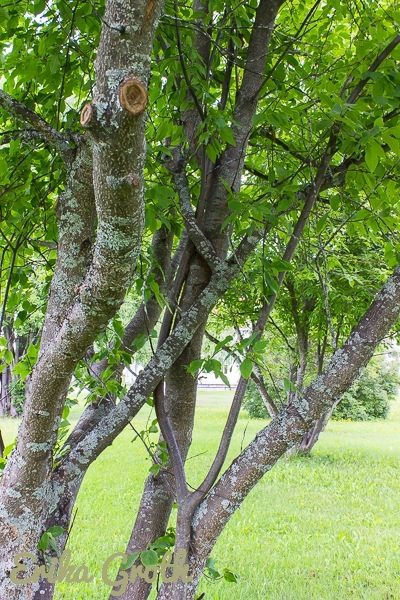
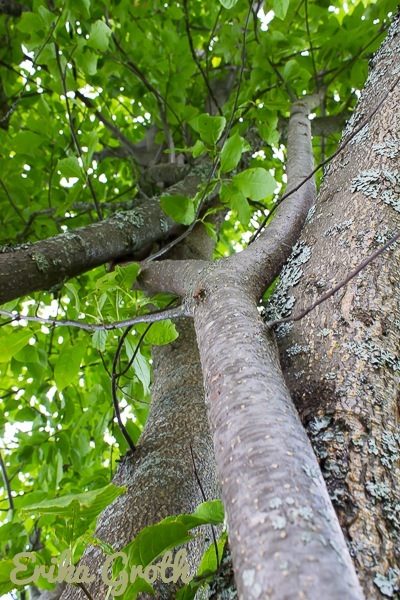 Juli har varit varm och torr. Väldigt varm och väldigt torr. Över +30°C nästan hela månaden, vilket på latitud 65,7 N knappast är en typisk juli månad. Jag gillar visserligen värme, men inte fullt så mycket och inte fullt så ihållande. Nu är i alla fall häggbären mogna. Sett på nära håll ser de ut som pyttesmå körsbär. Häggen tillhör samma släkte som körsbär och plommon och både det engelska (Bird Cherry) och det tyska (Echte Traubenkrische) namnen på hägg relaterar till körsbär. Det skandinaviska namnet hägg (svenska: hägg, norska: hegg, danska: almindelig hæg) är känt från medeltiden och tros härstamma från samma ordstam som hage.
Juli har varit varm och torr. Väldigt varm och väldigt torr. Över +30°C nästan hela månaden, vilket på latitud 65,7 N knappast är en typisk juli månad. Jag gillar visserligen värme, men inte fullt så mycket och inte fullt så ihållande. Nu är i alla fall häggbären mogna. Sett på nära håll ser de ut som pyttesmå körsbär. Häggen tillhör samma släkte som körsbär och plommon och både det engelska (Bird Cherry) och det tyska (Echte Traubenkrische) namnen på hägg relaterar till körsbär. Det skandinaviska namnet hägg (svenska: hägg, norska: hegg, danska: almindelig hæg) är känt från medeltiden och tros härstamma från samma ordstam som hage.
Häggbär är inte särskilt goda att äta men det har ändå förekommit att folk har ätit dem. Häggbär verkar ibland ha kallats fattigmanskörsbär. Men barken, och sannolikt även kärnorna, innehåller amygdalin. En gång i tiden trodde man att amygdalin var bra medicin mot cancer. Det var fel. I själva verket kan amygdalin orsaka cyanidförgiftning om man äter för mycket. Och för mycket amygdalin är inte alls mycket.
På den här trädet är stammarna ganska ordentligt intrasslade i varandra. De verkar liksom klamra sig fast vid varandra.
July has been warm and dry. Very warm and very dry. Over +30°C almost the entire month, which at latitude 65,7 N is not an average month of July. I like warmth, but not quite so much nor so long lasting. Anyway, now the berries on the bird cherry are ripe. Seen up close they look like tiny cherries. Bird cherry belong to the same genus as cherries and plums and both the English (Bird Cherry) and the German (Echte Traubenkrische) names for the species relate to cherries. The Scandinavian name hägg (Swedish: hägg, Norwegian: hegg, Danish: almindelig hæg) is known from the middle ages and is believed to be related to the word for pasture (hage).
The berries don’t taste very good but historically people have still occationally eaten them. They seem to sometimes have been called ”poor man’s cherries”. However, the bark, and probably also the seeds, contains amygdalin. Amygdalin was once believed to be effective medicin against cancer. That is not the case. In fact, amygdalin causes cyanide poisoning if you eat too much of it. And too much amygdalin is not much at all.
On this tree the stems are quite entangled with each other. It looks like they cling together.
Fotona är tagna i Älvsbyn 7 augusti 2018.
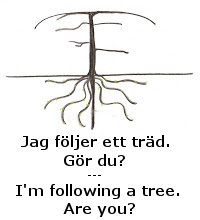 Kolla även in andra trädföljare på The Squirrelbasket (internationellt).
Kolla även in andra trädföljare på The Squirrelbasket (internationellt).

Those cherries remind me of our chokecherries (P. virginiana) in size and shape of clusters. They also are dark, but not as dark as yours. And they don’t taste very good, yet people always collect them … and then add lots of sugar to make syrup, and extra alcohol to the ”wine”. Traditions are so strong.
Yes, what people choose to collect and eat has little to do with what actually taste good and much more to do with what your parents and grandparents did. But enough sugar will after all make anything tasty enough. Like the classic rose hip soup (nyponsoppa) which is served warm (with or without vanilla ice cream melting in it) to children in Sweden as a ”healthy” snack or dessert. It does contain dried rose hips, but more importantly it also contains even more sugar per 100g than Coca Cola does.
What perfect black berries! VERY black, with no hint of red or purple, as far as I can see.
And the bark is beautiful with the delicate pattern and lichen.
You mention some interesting words – I wonder if our word ”hay”, meaning mown grass from a pasture, is related to ”hage”.
And I had forgotten that almonds belong to the same family as plums and cherries – hence the chemical ”amygdalin” from the Greek word for almond. And then there’s the ”amygdala” in the brain – again because they are almond shaped.
One thought leads to another…
All the best
Yes, the berries are black.
I guess hay could be related to hage or it may be related to the Swedish word for hay which is hö.
I like the lichen patterns on the tree, it is a nice shape and I expect the wildlife will enjoy the fruit,
you are further north and have had much higher temperatures, though you get colder winter,
Frances